Experimental Assessment of the Thermal Conductivity of Basalt Fibres at High Temperatures
Abstract
:1. Introduction
2. Relevance of the Research
3. Methodology
- -
- by thermal conductivity of the solid skeleton, which forms the porous structure;
- -
- by thermal conductivity of gas in pores and capillaries;
- -
- by radiation between the walls of pores and capillaries;
- -
- by convective heat transfer due to convective gas currents in the porous structure.
4. Results
4.1. Thermal Conductivity in Fibrous Thermal Insulation Materials for Cylindrical Samples
4.2. Influence of Temperature Modes of Operation on the Stability of the Heat-Shielding Properties
4.3. The Results of Thermogravimetric Analysis
5. Conclusions
Author Contributions
Funding
Institutional Review Board Statement
Informed Consent Statement
Data Availability Statement
Conflicts of Interest
References
- Apkaryan, A.S.; Kulkov, S.N. Study of the Thermophysical Properties of a Glass-Ceramic Material for Thermal Insulation of Pipelines of Heating Pipe Mains and Utilities. Inorg. Mater. Appl. Res. 2021, 12, 499–503. [Google Scholar] [CrossRef]
- Apkaryan, A.S.; Kulkov, S.N. Formation of structure and closed porosity under high-temperature firing of granules of porous glass-ceramic material. Inorg. Mater. Appl. Res. 2018, 9, 286–290. [Google Scholar] [CrossRef]
- Mozgova, A. Testing heat supply networks for heat losses. E3S Web Conf. 2021, 274, 08003. [Google Scholar] [CrossRef]
- Karabekova, D.Z.; Kissabekova, P.A.; Nussupbekov, B.R.; Khassenov, A.K. Analysis of the insulation state of underground pipelines in the heating network thermal engineering. Therm. Eng. 2021, 68, 802. [Google Scholar] [CrossRef]
- Lidén, P.; Adl-Zarrabi, B.; Hagentoft, C.E. Diagnostic protocol for thermal performance of district heating pipes in operation. Part 2: Estimation of present thermal conductivity in aged pipe insulation. Energies 2021, 14, 5302. [Google Scholar] [CrossRef]
- Berge, A.; Adl-Zarrabi, B.; Hagentoft, C.E. Assessing the thermal performance of district heating twin pipes with vacuum insulation panels. Energy Procedia 2015, 78, 382–387. [Google Scholar] [CrossRef] [Green Version]
- Park, J.W.; Lim, O.K.; You, W.J. Analysis on the fire growth rate index considering of scale factor, volume fraction, and ignition heat source for polyethylene foam pipe insulation. Energies 2020, 13, 3644. [Google Scholar] [CrossRef]
- Krawczyk, D.A.; Teleszewski, T.J. Reduction of heat losses in a pre-insulated network located in central Poland by lowering the operating temperature of the water and the use of egg-shaped thermal insulation: A case study. Energies 2019, 12, 2104. [Google Scholar] [CrossRef] [Green Version]
- Teleszewski, T.J.; Krawczyk, D.A.; Rodero, A. Reduction of heat losses using quadruple heating pre-insulated networks: A case study. Energies 2019, 12, 4699. [Google Scholar] [CrossRef] [Green Version]
- Ministry of Economic Development of the Russian Federation. State Report on the State of Energy Conservation and Energy Efficiency in the Russian Federation. Available online: https://www.economy.gov.ru/ (accessed on 17 February 2022).
- Fuel and Energy Complex and Economy of Russian Regions. Directory; Publishing House Energiya: Moscow, Russia, 2007; Volume 4.
- Guryev, V.V.; Zholudov, V.S.; Petrov-Denisov, V.G. Thermal Insulation in Industry. Theory and Calculation; Stroyizdat: Moscow, Russia, 2003; p. 416. [Google Scholar]
- Order of the Ministry of Energy of the Russian Federation of 30 December 2008 No. 325 “On Approval of the Procedure for Determining the Standards for Technological Losses during the Transfer of Heat Energy, Heat Carrier”; Ministry of Energy: Moscow, Russia, 2008. Available online: https://minenergo.gov.ru/ (accessed on 17 February 2022).
- Zhao, J.-F.; Qiao, L.-B.; Yang, H.-L.; Zhang, L.; Yu, Z.-T. Experimental study on characteristics of thermal and pipeline loss of steam heating pipeline network. Zhejiang Daxue Xuebao (Gongxue Ban)/J. Zhejiang Univ. (Eng. Sci.) 2021, 55, 1135–1141. [Google Scholar]
- Elagina, O.Y.; Ageeva, V.N.; Buklakov, A.G. Some aspects of heat-insulating materials application on systems of oil fields steam pipelines. Neftyanoe Khozyaystvo-Oil Ind. 2019, 10, 87–89. [Google Scholar] [CrossRef]
- Berardi, U. The impact of aging and environmental conditions on the effective thermal conductivity of several foam materials. Energy 2019, 182, 777–794. [Google Scholar] [CrossRef]
- Berardi, U.; Naldi, M. The impact of the temperature dependent thermal conductivity of insulating materials on the effective building envelope performance. Energy Build. 2017, 144, 262–275. [Google Scholar] [CrossRef]
- Berardi, U.; Nikafkar, M.; Wi, S.; Kim, S. Experimental verification of the theoretical aging of vacuum insulated panels. J. Ind. Eng. Chem. 2020, 90, 300–304. [Google Scholar] [CrossRef]
- Li, A.V. Durability of Energy-Efficient Polymer-Containing Enclosing Structures: Thesis for the Degree of Cand. of Tech. Sciences. Ph.D. Thesis, Far Eastern State Technical University University, Khabarovsk, Russia, 2003. [Google Scholar]
- Ivantsov, A.I. Prediction of the Service Life of the Outer Walls of Residential Buildings Based on the Loss of the Required Thermal Protection: Thesis for the Degree of Cand. of Tech. Sciences. Ph.D. Thesis, Kazan State University of Architecture and Civil Engineering, Kazan, Russia, 2014. [Google Scholar]
- Bobrov, Y.L. Durability of Thermal Insulation Mineral Wool Materials; Stroyizdat: Moscow, Russia, 1987. [Google Scholar]
- Pavlov, M.; Karpov, D.; Akhmetova, I.; Monarkin, N. Assessment of energy efficiency of application heat-insulating paint for the needs of district heat supply systems. E3S Web Conf. 2020, 178, 01004. [Google Scholar] [CrossRef]
- Behi, H.; Behi, M.; Ghanbarpour, A.; Karimi, D.; Azad, A.; Ghanbarpour, M.; Behnia, M. Enhancement of the Thermal Energy Storage Using Heat-Pipe-Assisted Phase Change Material. Energies 2021, 14, 6176. [Google Scholar] [CrossRef]
- Zholudov, V.S. Improving the Heat-Shielding Properties of Heat-Insulating Structures Made of Fibrous Materials for Industrial Structures: Thesis for the Degree of Cand. of Tech. Sciences. Ph.D. Thesis, Russian State Open Technical University of Railways, Moscow, Russia, 2000. [Google Scholar]
- The Russian State Standard GOST 32025-2012. Thermal Insulation. Method for Determining the Characteristics of Heat Transfer in Factory-Made Cylinders in a Stationary Thermal Regime. Available online: https://docs.cntd.ru/document/1200101975 (accessed on 17 February 2022).
- Bazukova, E.; Vankov, Y. Increasing the reliability of thermal energy transportation systems taking into account forecasting the properties of thermal insulation during operation. E3S Web Conf. 2020, 216, 01078. [Google Scholar] [CrossRef]
- Bazukova, E.R.; Vankov, Y.; Gaponenko, S.O.; Smirnov, N.N. Investigation of the thermal conductivity coefficient of basalt fiber insulation at various temperature conditions. ISEU Bull. 2021, 4, 15. [Google Scholar]
- The Russian State Standard GOST 7076-99; Building Materials and Products. Method for Determination of Thermal Conductivity and Thermal Resistance under Stationary Thermal Conditions. Gosstroy of Russia, GUP TsPP: Moscow, Russia, 2000. Available online: https://docs.cntd.ru/document/1200005006 (accessed on 17 February 2022).
- Saifullin, E.R.; Vankov, Y.V.; Bazukova, E.R.; Maryashev, A.V. Evaluation of heat transporting losses due to changes of insulation properties during operation. J. Phys. Conf. Ser. 2018, 1058, 012061. [Google Scholar] [CrossRef]
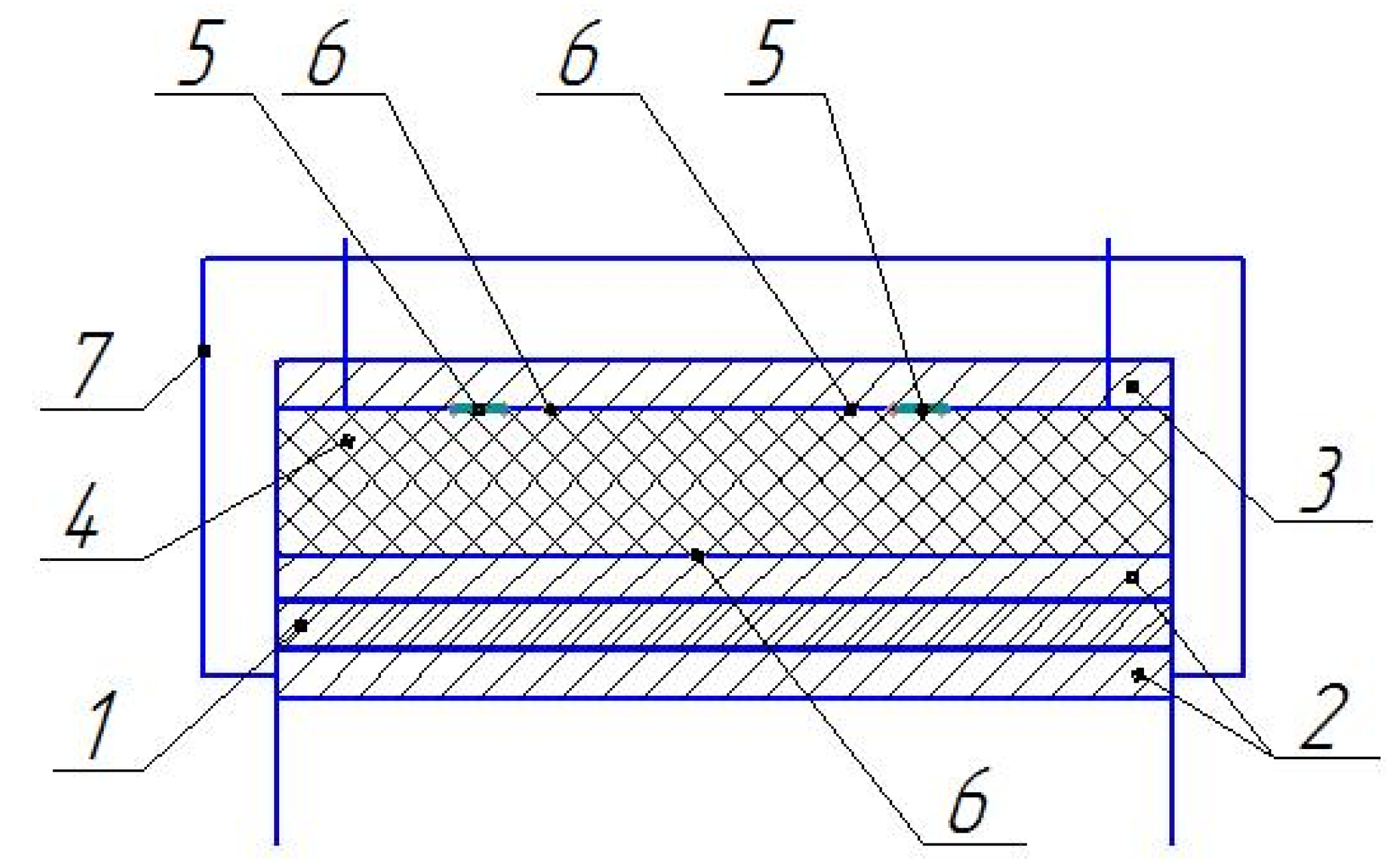
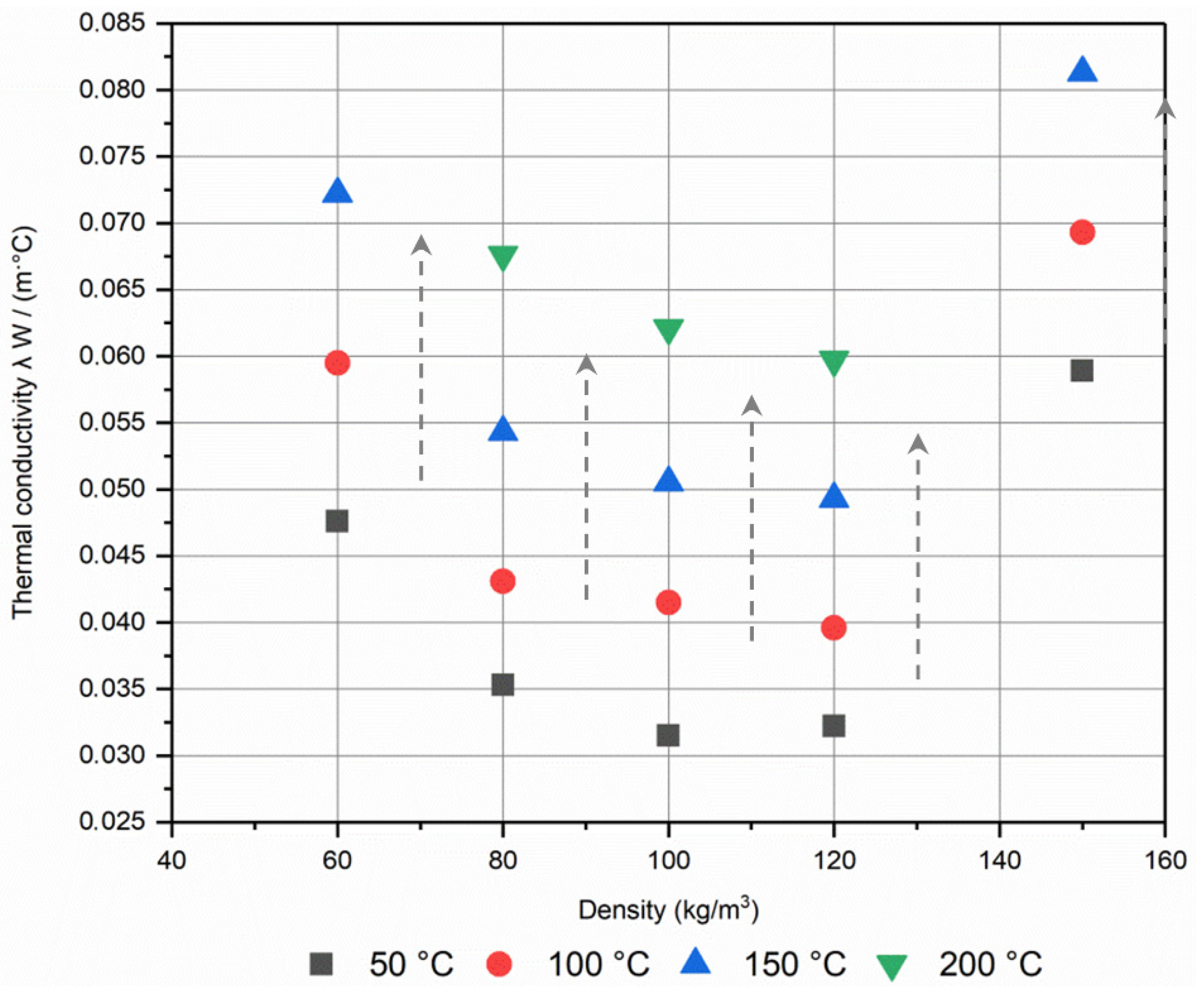
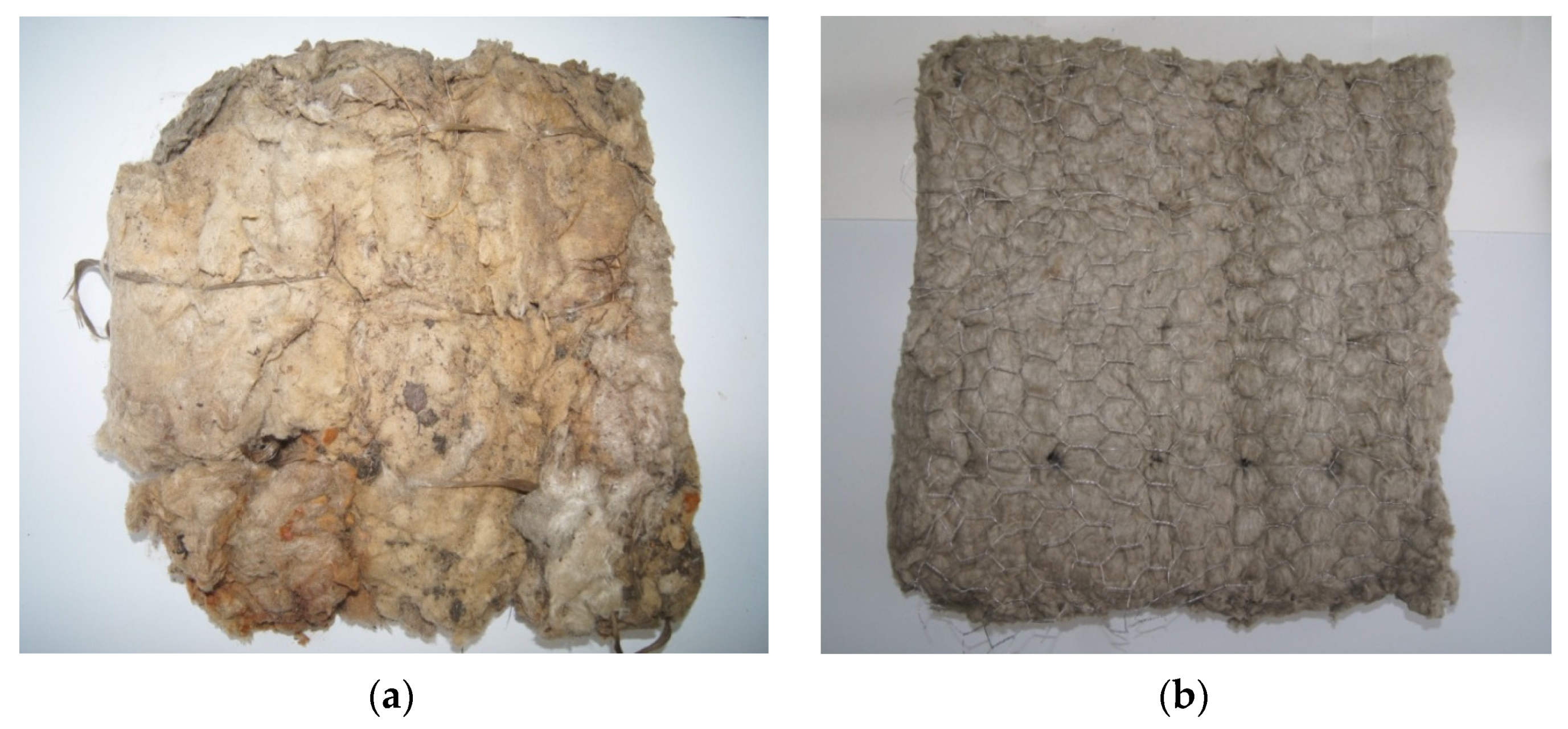
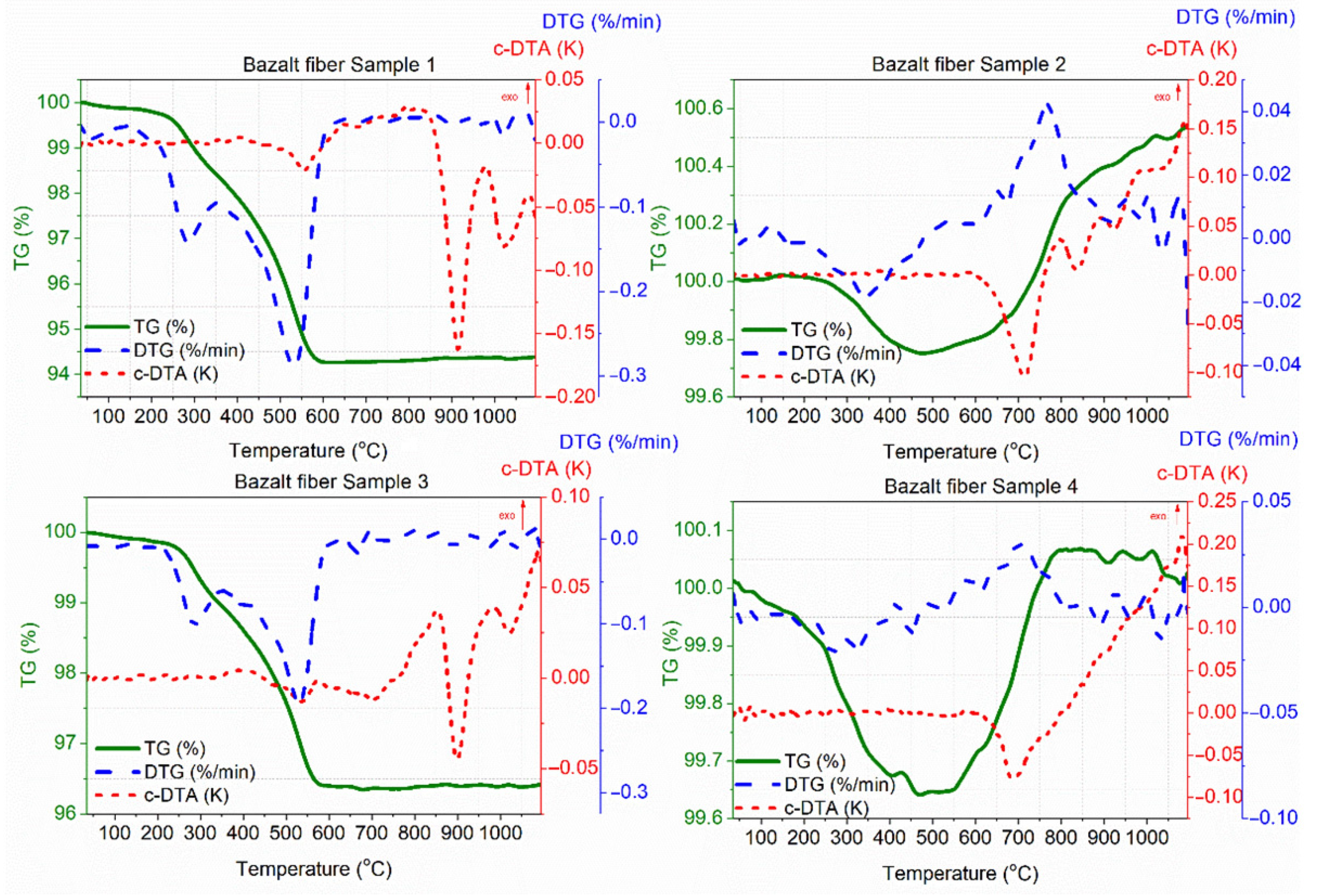

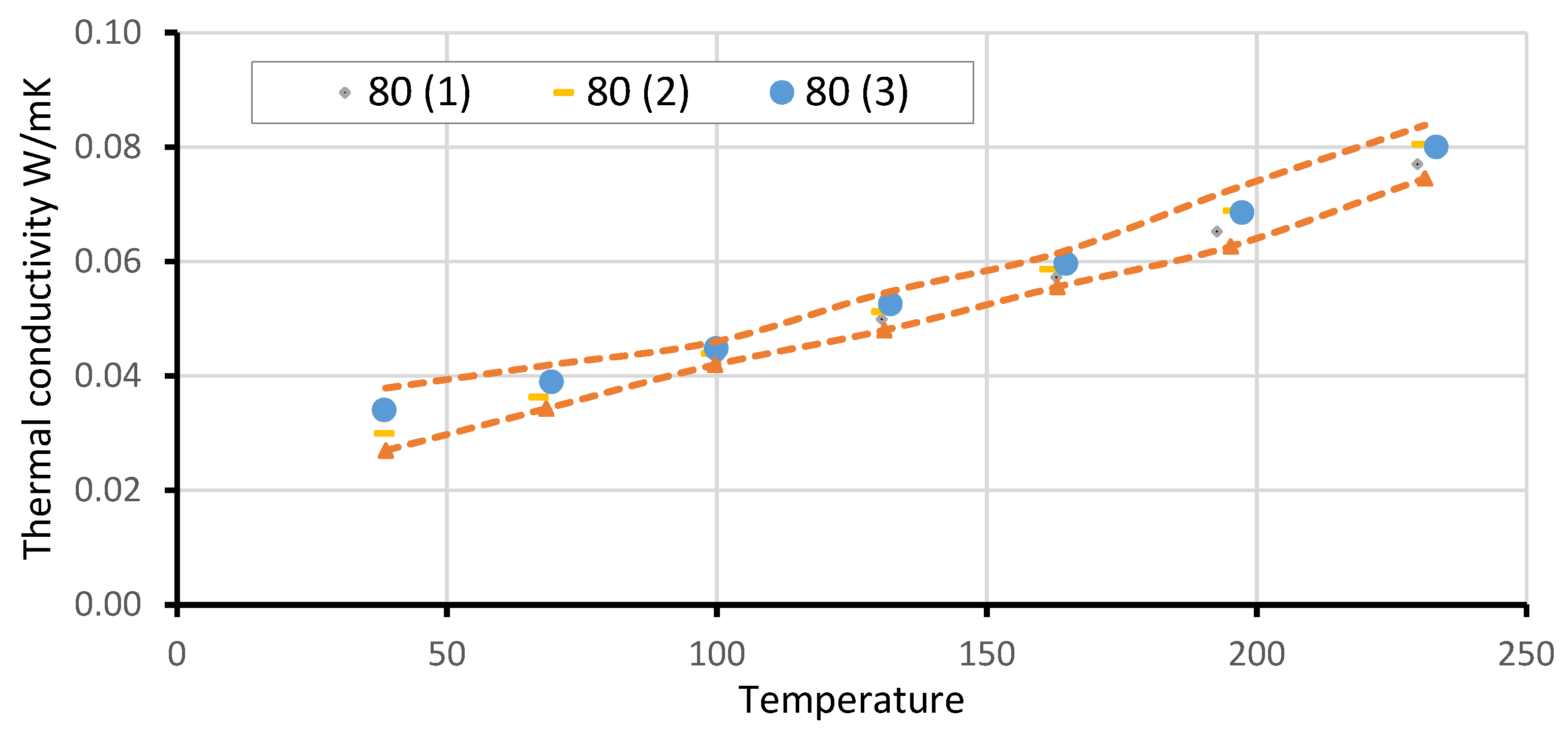
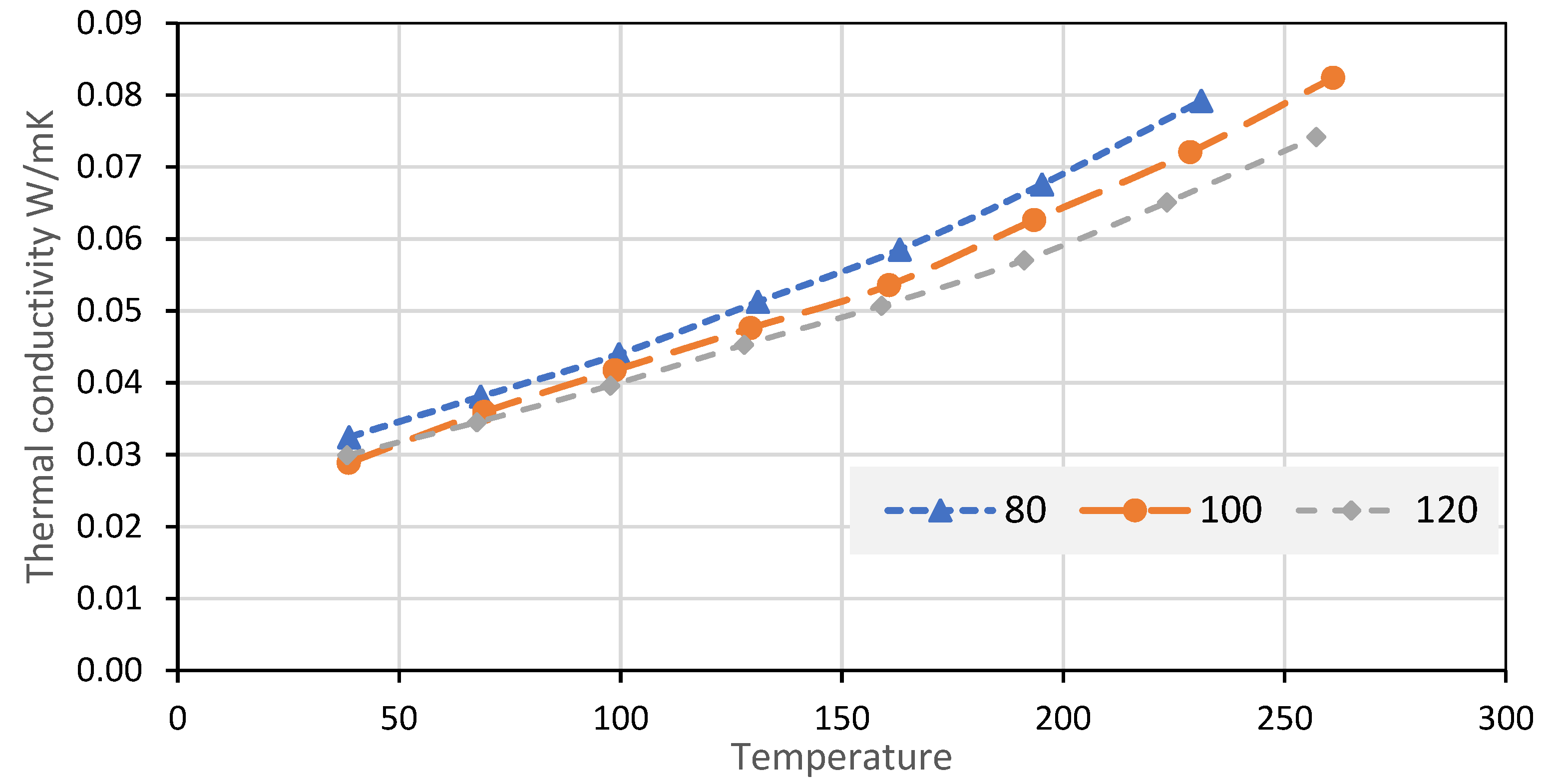
| New Basalt Sample No. | Δm1 30–300 °C (%) | Δm2 300–650 °C (%) | Δm3 650–1000 °C (%) | DTG 1 (°C) | DTG 2 (°C) | DTG 3 (°C) |
| 1 | 1.57 | 4.16 | 0.09 | 283.4 | 535.2 | 909.3 |
| 3 | 1.05 | 2.56 | 0.01 | 289.4 | 528.0 | 887.6 |
| Used Basalt Sample No. | Δm1 30–500 °C (%) | Δm2 500–800 °C (%) | Δm3 900–1000 °C (%) | DTG 1 (°C) | DTG 2 (°C) | DTG 3 (°C) |
| 2 | 0.24 | +0.51 | +0.22 | 339.7 | 758.7 | 979.4 |
| 4 | 0.35 | +0.42 | 0.01 | 272.0 | 696.3 | 1032.6 |
| Temperature of the Insulated Pipe, °C | Average Temperature of the Insulation °C | Coefficient of Thermal Conductivity W/(m°C) | ||||
|---|---|---|---|---|---|---|
| Density of 80 kg/m3 | Density of 100 kg/m3 | Density of 120 kg/m3 | Density of 80 kg/m3 | Density of 100 kg/m3 | Density of 120 kg/m3 | |
| 50 | 39 | 39 | 38 | 0.0324 | 0.0289 | 0.0299 |
| 100 | 68 | 69 | 68 | 0.0381 | 0.0359 | 0.0345 |
| 150 | 100 | 99 | 98 | 0.0440 | 0.0417 | 0.0396 |
| 200 | 131 | 129 | 128 | 0.0512 | 0.0476 | 0.0453 |
| 250 | 163 | 161 | 159 | 0.0585 | 0.0535 | 0.0507 |
| 300 | 195 | 193 | 191 | 0.0676 | 0.0626 | 0.0570 |
| 350 | 231 | 229 | 223 | 0.0792 | 0.0720 | 0.0651 |
| 400 | - | 261 | 257 | - | 0.0824 | 0.0741 |
Publisher’s Note: MDPI stays neutral with regard to jurisdictional claims in published maps and institutional affiliations. |
© 2022 by the authors. Licensee MDPI, Basel, Switzerland. This article is an open access article distributed under the terms and conditions of the Creative Commons Attribution (CC BY) license (https://creativecommons.org/licenses/by/4.0/).
Share and Cite
Vankov, Y.; Bazukova, E.; Emelyanov, D.; Fedyukhin, A.; Afanaseva, O.; Akhmetova, I.; Berardi, U. Experimental Assessment of the Thermal Conductivity of Basalt Fibres at High Temperatures. Energies 2022, 15, 2784. https://doi.org/10.3390/en15082784
Vankov Y, Bazukova E, Emelyanov D, Fedyukhin A, Afanaseva O, Akhmetova I, Berardi U. Experimental Assessment of the Thermal Conductivity of Basalt Fibres at High Temperatures. Energies. 2022; 15(8):2784. https://doi.org/10.3390/en15082784
Chicago/Turabian StyleVankov, Yuri, Elvira Bazukova, Dmitry Emelyanov, Alexander Fedyukhin, Olga Afanaseva, Irina Akhmetova, and Umberto Berardi. 2022. "Experimental Assessment of the Thermal Conductivity of Basalt Fibres at High Temperatures" Energies 15, no. 8: 2784. https://doi.org/10.3390/en15082784
APA StyleVankov, Y., Bazukova, E., Emelyanov, D., Fedyukhin, A., Afanaseva, O., Akhmetova, I., & Berardi, U. (2022). Experimental Assessment of the Thermal Conductivity of Basalt Fibres at High Temperatures. Energies, 15(8), 2784. https://doi.org/10.3390/en15082784










